The Tyneside Tramways and Tramroads Company Limited
The Tyneside Tramways and Tramroads Company Limited
I am extremely grateful to Tony Fox, and Bill Donald, for their help in putting this article together. The Tyneside name ceased to exist as an identity in 1975, inevitably, some records have been lost entirely, and in instances where I am aware of more than one account of events, I have pointed this out, nevertheless, I do not claim that the article is 100% accurate.

This is a relatively modern map, but it illustrates Tyneside's tram routes to North Shields and Gosforth, it does not show the route into Newcastle City Centre. Some records say the terminus was Stanhope Street, whilst others say Central Station. I am not familiar with Newcastle's tram network, but the two places are not that far apart, and travelling from Wallsend, Stanhope Street is beyond the Central Station, so possibly it went to one via the other. Tyneside's depot 'the black square at the end of the spur' was situated in Neptune Road Wallsend; behind ‘Thermal Syndicate' offices overlooking Swan Hunters Shipyard. In the 60's, the factory was extended, and the buses were relocated to a new purpose built depot about half a mile east along Hadrian Road 'shown as a red square' what remained of the old depot became an ambulance station, apparently the tracks were not removed until 1975. Tyneside became part of the British Electric Traction Company in 1913; ideally, where the Tyneside and Tynemouth and District systems met, they would have been joined to form a through route from Newcastle to Whitley Bay. However, this proved to be a none starter as the track gauges were not compatible, Tyneside ran on 4ft 8½" standard gauge, Tynemouth none standard 3ft 6" and the cost of conversion would have been enormous. However, where the two sets of tracks met, at the junction of Prudhoe Street and Saville Street, a short third rail overlap was created. Accounts differ as to which side of the junction the overlap was actually on, but I believe that it was unique in the British Isles. The last Tyneside tram ran on 6th April 1930: Bus services commenced with the two routes inherited from the trams, neither was numbered, but they were known locally as 'The green bus' the somewhat long-winded company name remained the same until 1965, when they became the Tyneside Omnibus Company Limited.
Tyneside Tramways and Tramroads Company Limited; played a smaller, but none the less significant role in the pre National Bus Company history of public transport in North Tyneside. The story begins on 4th September 1902, with the opening of a tram service from North Shields to the Wallsend/Newcastle Boundary; from that point onwards, they ran on Newcastle Corporation Tramways track. As far as I am aware, the revenue taken on that section of the route went to Newcastle Corporation, and Tyneside received payment for the mileage they covered. They also had a second route from Wallsend to Gosforth. Until the early 50''s the fleet numbers had a TT prefix, but never exceeding more than around twenty vehicles in total, to the best of my knowledge, Tyneside was the smallest of the Northern General Transport Group subsidiary companies. Their close neighbours Wakefields Motors Limited, had fewer service buses, but they also had coaches, so in altogether they had more vehicles than Tyneside.

Tyneside tram about 1910. Unlike Tynemouth's drivers, Tyneside's had the luxury of an enclosed cab.
The livery was dark leaf green and cream, and the buses were sage green and cream
After the First World War, Towns and Cities began to expand rapidly, consequently bus services were need to serve the needs of the ever- increasing populations. Tynemouth and District Electric Traction Company Limited began bus services in 1921; Tyneside Tramways and Tramroads Company Limited may have begun bus services at roughly the same time. However, according to the fleet records, Tyneside did not have any buses prior to 1930; but it is entirely possible they will have held stage carriage licences, which would explain the confusion. What is not in dispute is that Tynemouth and District operated a route from North Shields to Blyth via Whitley Bay. Accounts differ as to how this particular service came about. One version of events is that T&D successfully applied for licences to operate other routes in the North Shields and Wallsend areas. Meanwhile, Tilling Group rivals United, were expanding their stage carriage operations into South East Northumberland. BET regarded this as a threat, so to protect their ' territory' from further encroachment, T&D applied for a licence to run the service to Blyth, they were successful and the licence was granted. Another interpretation is that United objected and the application was refused. However, BET had anticipated an objection and had submitted a second application through Tyneside, and this proved to be successful. Nevertheless, I have been unable to find any documented evidence that Tyneside simultaneously ran tram and bus services alongside each other. If indeed they were granted the licence, it's possible that T&D operated the service on Tyneside's behalf. Obviously both cannot be right, and I am not prepared to speculate as to which of them is.
Tram Replacements
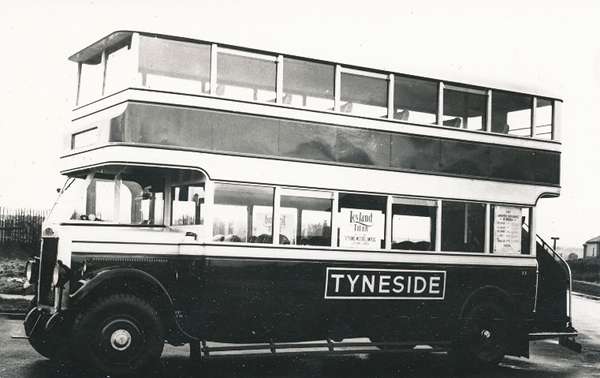
Six L27/24RO all Leyland TD1's, arrived in 1930, TY 6970/75 initially numbered 31/36 but renumbered 1/6 in 1936. TY 7398 and 7913 numbered 7/8, followed them later the same year.
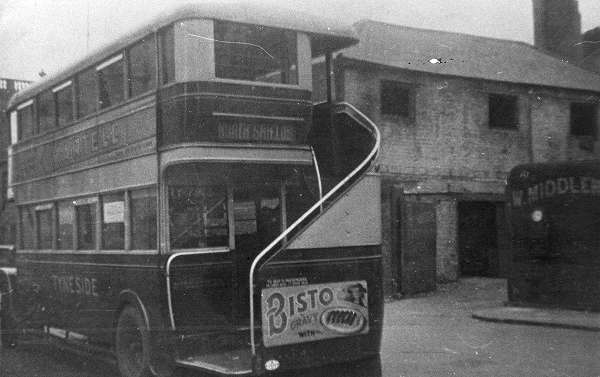
A rear view of what appears to be TY 7913
I have conflicting accounts as to what happened to these vehicles afterwards. Version 1, states that 1/4/7&8 were given H30/26R Northern Coachbuilders bodies in 1943 and by 1946, they had all been fitted with diesel engines. They were sold to Robson Bros of Haltwhistle in 1951, with 4 eventually becoming a Showman's vehicle. Version 2 is that post war 1/4/7&8 were returned to Leyland to have the chassis overhauled and to be rebodied, and they came back as 28-31. Personally, I doubt this, my reasons being. In the 40's & 50's, many NGT group buses were rebodied, some which were originally from SDO & T&D were renumbered and allocated to different depots, but invariably they all retained their original registrations. Other records have 28/9&30 as a PD1 and 31 as a PD2 with new issue registrations. Wilts and Dorset bought 2/3/5; they were rebodied by ECW and fitted with Gardner 5LW engines, 6 was requisitioned by the Ministry of Transport in 1939 and went to Buckland of Perth.
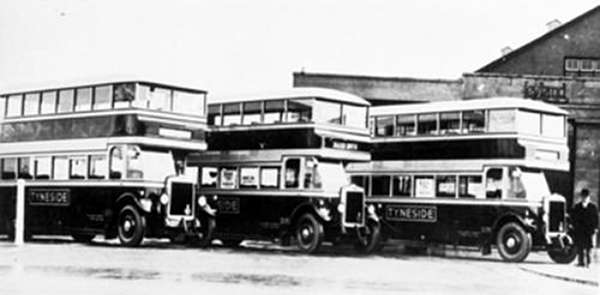
Pictured at Hodgson's on Benfield Road; the Leyland dealer for Newcastle, are three H27/24R all Leyland TD1 in Tyneside livery and numbered 9/11. New vehicles ordered by Tyneside had Northumberland registrations, but VK 3839/41 are Newcastle. They were delivered to Newcastle Corporation in January 1931, but were never numbered as part of their fleet. One explanation is that Newcastle wanted to retain an interest in the former tram route they had shared with Tyneside, but The County Borough of Tynemouth would not allow Newcastle Corporation vehicles within its boundaries. However, they had been operating on the Newcastle Tynemouth service 11, since 1928, this route was shared with Tynemouth and District and Wakefields, so I am not entirely convinced. Be that as it may, by the end of 1931, they moved to Wallsend, and remained with Tyneside until they were withdrawn from service in 1938, which seems a very short life for a Leyland. They were bought by Barton Transport, Chilwell, and rebodied by Duple as L55F.
It's not clear if they came before or after the TS3A's from Southdown, but between 1930 & 1931 Tyneside borrowed nine vehicles from Newcastle Corporation. Three CF6 Daimler demonstrators UB 1569 - VC 3882 and VR 5898. The Daimlers were later purchased by Lanarkshire Traction Company. The other six were English Electric H26/26R AEC Regents, VK 2378/9/70 May/June in 1930, then VK 2397/8/9 July 1930 to January 1931.
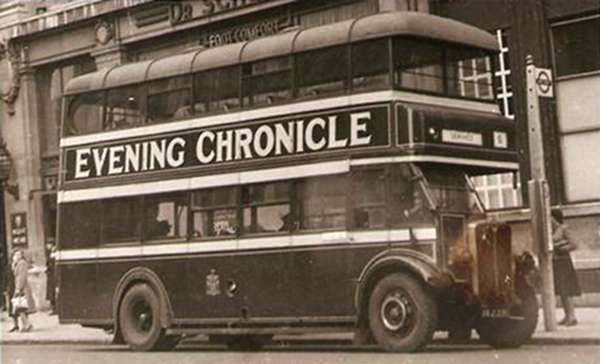
I don't know if any more of the other Newcastle Corporation AEC's which had been loaned to Tyneside were involved, but VK 2399 certainly got around. It had a spell on wartime service with London Transport, but was still in Newcastle livery.
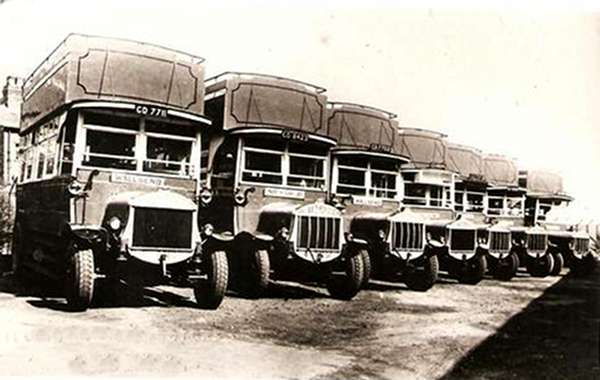
Eight O27/24RO Tilling Stevens TS3A petrol electrics were bought from Southdown. One each from 1920 & 22, the rest were 1923. Registered in Brighton, they had a CD index but the numbers were not in sequence. They were allocated Tyneside fleet numbers 37/44.
43; CD 6834 - 1923
44; CD 6894 - 1922
42; CD 7703 - 1923
37; CD 7708 - 1923
38; CD 7711 - 1923
41; CD 8013 - 1923
43; CD 8282 - 1920
39; CD 8423 - 1923
Their Southdown fleet numbers were 201 - 94 -203/7/11/13, 82 & 223 respectively. 43 was originally numbered CD 5624, but was rebodied and reregistered in 1923 following a fire. They came to Tyneside from Southdown via Tilling Stevens in either 1930 or 1931 and had all been withdrawn by 1939.
12 - JR 773: an H27/24R all Leyland TD2 new in 1932, it was fitted with a diesel engine in 1946 and withdrawn in 1949. No further records found.
13 - JR 2393: an H27/25R all Leyland TD3c. In 1946, Burlingham rebodied it as H30/26R a diesel engine was fitted, on its return from Burlingham it was it reallocated to Gateshead. In 1956 it was sold to a building contractor in Hetton Le Hole, for use as a staff transport vehicle.
14/16 - JR 4049/51: H30/26R all Leyland TD4c new in 1935. Withdrawn in 1952, no further records found.
17 - TJ 4511: a 1933 H24/24F Weymann bodied Leyland TD3c demonstrator. It was bought by Tyneside in 1935, and rebodied by Northern Coachbuilders in 1944. It was withdrawn in 1952 and became a Showman's vehicle. Presumably it was similar to the 1938 forward entrance Weymann bodied TD5's of T&D, which can be found in my article about Percy Main.
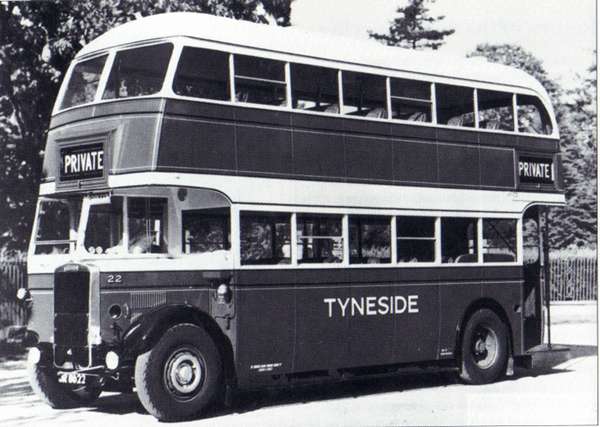
A hansom 1938 Leyland TD5, its one of nine ordered by Tyneside. JR 8618/26 - 18/26. The body is an ECW design, but some records indicate that it was Leeds Coachbuilders Charles Roe who built them; they were the last buses to be delivered before WWII. They had long lives and were not withdrawn until 1954. Records suggest 18/22/3/4/5&6 went to Showmen, and 19/20&21 were sold to a dealer in London, but nothing further can be found. Its strange how many of Tyneside's vehicles seemed to go to Showmen.
CN 5242: a 1931 Brush bodied AEC Regent; Apparently Tyneside's only diesel engined AEC. It was new to Northern as 564; 1n 1932 it was transferred to Tynemouth where it became 50. It moved to Tyneside in 1941 and became No 27. Rebodied by Northern Coachbuilders in 1946, it returned to Northern as 1403.
Post War
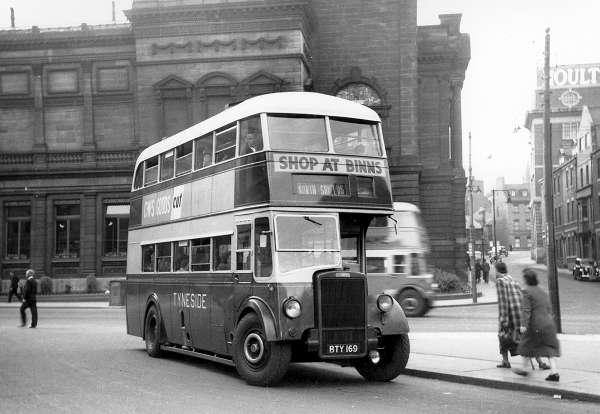
Tyneside's first post war buses were three 1946, H30/26R all Leyland PD1 Titans BTY 168/70 - 28/30. 31/33 - CTY 331/333: 1948 H30/26R all Leyland PD2/1. Officially on long term loan, 28/30 & 31/33, were transferred to Tynemouth 1958. They were repainted in T&D livery but retained Tyneside fleet numbers. 34/37 - ENL 680/683 1951 H30/26R all Leyland PD2/3. 34&6 went to F Cowley of Salford.
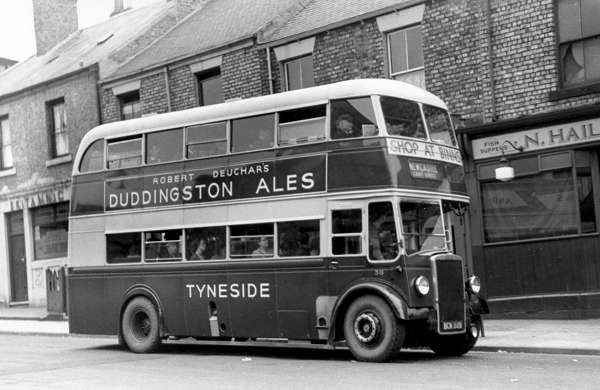
This PD2/3 was the last Tyneside bus to enter service before the arrival of the 1954 Orion bodied PD2/12's. Its fleet number was 38; but, BCN 889 is a Gateshead registration. It was new in 1951, records say it was transferred from Gateshead the same year, but all Gateshead half cabs had a Newcastle Corporation style destination layout, and this one does not. Personally, I am inclined to think it may have been diverted to Tyneside before it left the Leyland factory, and never actually enter service with Gateshead. 35 - 37&8 were sold to Alexander (Greyhound) of Arbroath.
Here I go off on one of my rants again. Tyneside's Newcastle terminus was in Croft Street; literally two minutes from the bottom of Northumberland Street, the main shopping thoroughfare in Newcastle. The building behind, is the old City Library in New Bridge Street. In the 70's, several of the Cities Councillors stood trial for corruption and subsequently became guests in one of Her Majesty's Prisons. Unfortunately, it came too late to save this, and many more of the City Centres beautiful buildings. Like many other Cities, Newcastle had its heart ripped out and destroyed. A hideous modern monstrosity, which has since been demolished, replaced the Library; at the time, it was called ‘progress' today it would be criminal damage.
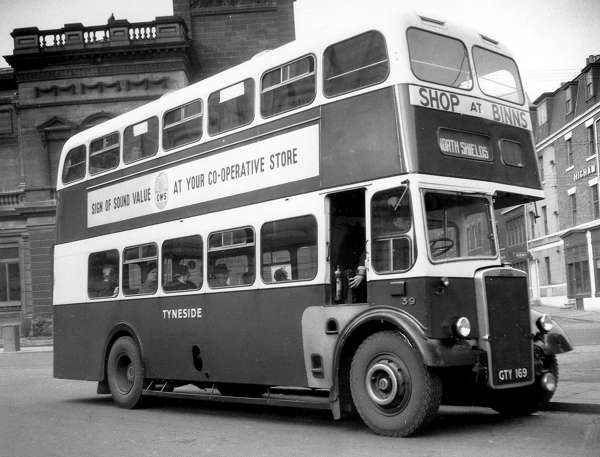
In 1954, Tyneside took delivery of nine H35/28R - MCW Orion bodied Leyland PD2/12's GTY 169/77 39/47.
The other end of the route was Borough Road North Shields.
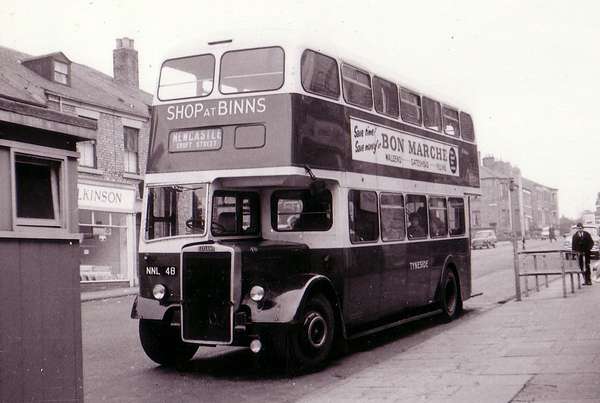
Tyneside had three 1958 H41/32R MCW Orion bodied Leyland PD3/4's - NNL 48/50 - 48/50; Although in Tyneside livery, they spent the first months of their lives on loan to Tynemouth and District. After withdrawal 48 and 50 became Northern Group training buses, a rather different fate awaited 49.
Late comers to the world of rear engine buses. Tyneside were nearly four years behind T&D with these PDR1/1 MKII Leyland Atlantean‘s; they were in fact the last D/D depot in the group to get them.
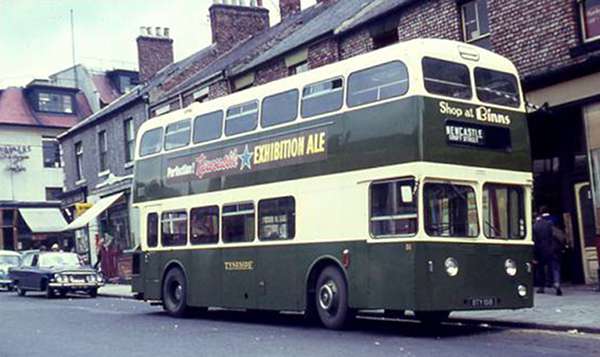
The first three BTY 151/3B - 51/3 arrived in 1964, they had H43/32F Weymann bodies, and rather suited the Tyneside livery. The style of lettering on the Shop at Binns logo would make this photo no earlier than 1966. This is not the last time we shall see this vehicle, so prepare yourselves for a shock.
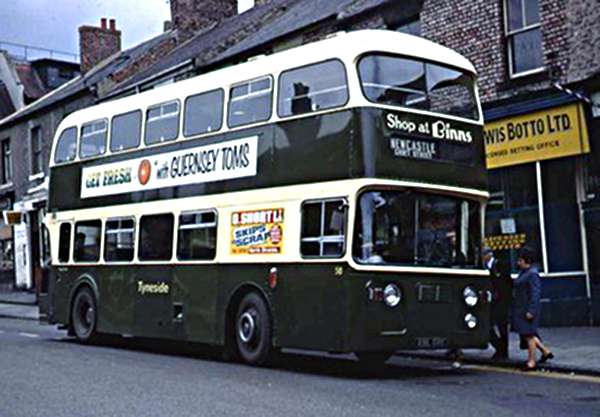
Between 1965 & 67, Tyneside took delivery of six PDR1/1 MKII Atlanteans with the superb H43/32F Alexander body; ENL 354/5C 54/5 in 1965 - HJR 656/7D 56/7 in 1966 - KNL 58/9E 58/9 in 1967 and one more in 1968, NNL 60F - 60 which had an H44/33F version of the body. This was to be Tyneside's last new D/D pre NBC. By the end of 1973, all Tyneside's vehicles had been painted in a hideous livery.
The start of OPO operations in 1969, and Tyneside ventured into what for them had previously been unexplored territory, they took delivery of their first single deck buses.
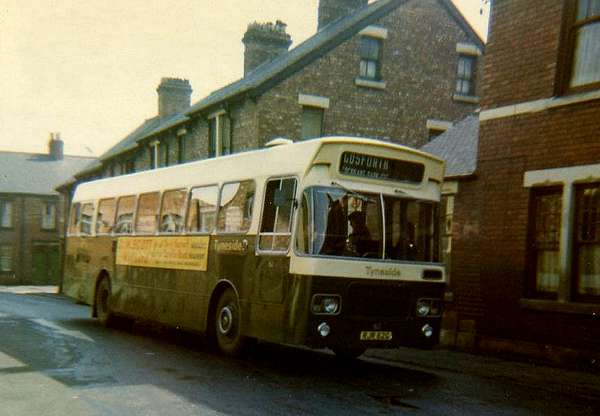
Two B48D Marshall Camair bodied PSUR1A/1R Leyland Panthers - RJR 61/2G - 61/2, were the only single deck vehicles to carry the Tyneside name. Two Bristol RELL ECW B44D's which were scheduled to arrive, and would have been 63/4, were diverted to Gateshead, 61/2 were transferred with them. Tyneside were allocated two former SDO Burlingham bodied PD3's. YPT 289&292 which became 66/7, They were painted yellow rather than green.
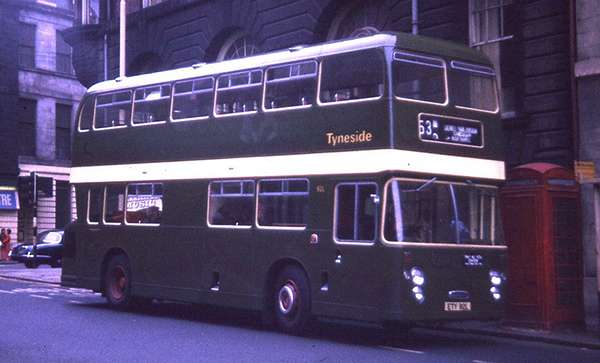
Strictly speaking, these 1973 Daimlers are too young for this site, but the chassis and body type ‘not necessarily in this combination' had been around for a while, and they illustrate how fleets changed post NBC. Tyneside had five H45/27D - ECW bodied CRL6 Daimler Fleetlines, ETY 90/94L, they were the only Tyneside buses in the short-lived NBC green layout, before they became T&W yellow, and were the last to carry the Tyneside name. The fleet numbers had gone haywire; they were 90/94L. 92L is seen here on loan to Gateshead.
Life after Tyneside
After withdrawal from service, all 1954 intake had extended lives, 39 was bought by Samuel Ledgard, 40 went to Wells of Hatfield. 41/2/5&6 became Northern Group training buses, and 43/4 went to Patton Bros of Renfrew. By the time this photo was taken, 45 was at least 14 years old, it's still in Tyneside green, the name has been changed but other than that it's in more or less in the same condition as it was the last time it carried passengers.
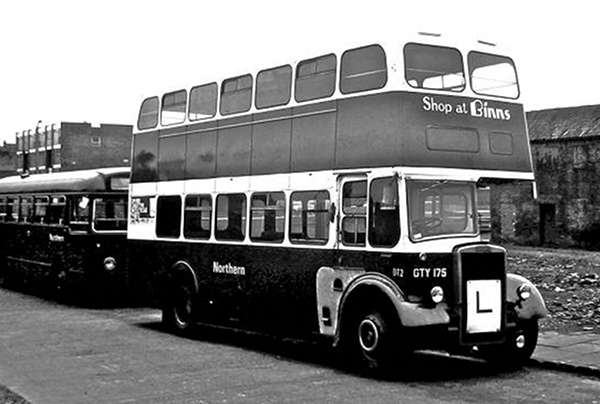
47, had a different ending. It went to the central engineering department at Bensham, where it was converted into a mobile workshop come towing vehicle, after that it became a 'tree lopper' it was still around as late as 1980
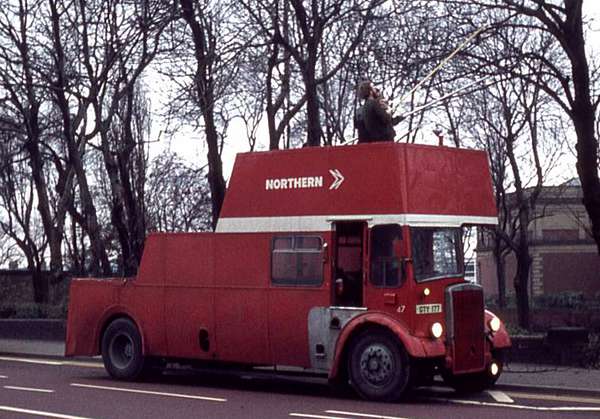
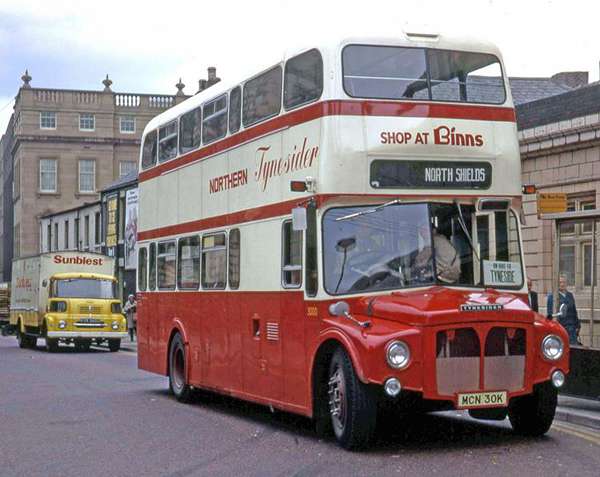
A very high proportion of Tyneside's vehicles saw further service with other companies, and a surprising number went to Fairground Showmen. Inevitably, others went straight for scrap, but of all Tyneside's buses, it was 49, which was to have the most unusual ending. Around 1969, it was involved in a serious accident, and at one stage it was being cannibalised for spares, however, the development team at NGT decided to see if a cost effective conversion could be found of front engine vehicles for OPO operations. This was the result, one of the Routemasters was given a slightly less radical treatment, they were named Tynesider and Wearsider. They were a brave attempt, but a failure. For a while, this one was based at Percy Main, but only used for staff transport.
New Tyneside vehicles were NL - JR or TY Northumberland County registrations, this one was reregistered after its rebuild. Ironically, it has survived into preservation. To date it is located somewhere in the Liverpool area.
Finally
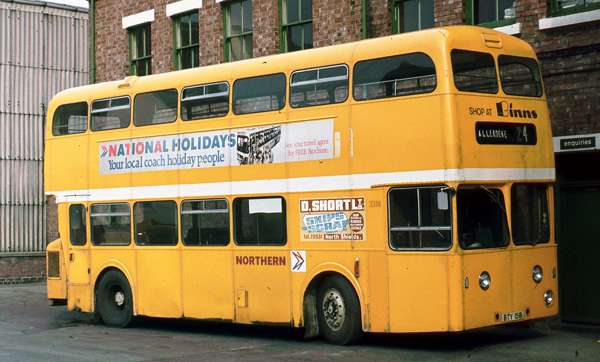
All BET and Tilling Group companies suffered when the National Bus Company was created, and my views on the subject are no secret; even small depots like Tyneside were not immune from the disease of apathy and neglect. As well as the introduction of an atrocious corporate livery, they lost their identity and fleet numbers, and the vehicles looked neglected. BTY 151B is typical; Wheel trims gone, no shine and the paintwork looking like a patchwork quilt, hard to believe this is the same well cared for vehicle we saw earlier looking resplendent in sage green and cream. The destination suggests the vehicle was now part of the Gateshead fleet.
Following the creation of NBC, the name, livery and fleet numbers were changed, but the depot was still on the go, and both the routes were still in operation, but the newly formed T&W PTE had other ideas. The Corporation fleets of Newcastle, South Shields and Sunderland came together as a single unit, in a common livery; the PTE took administrative control of all routes wholly within Tyne and Wear boundaries, and decided that no two routes within the area would have the same number. Virtually everything changed; Newcastle Corporation's route numbers started at 1, and with a few exceptions remained more or less the same. The numbers radiated out from Newcastle and some went up into the 800's. The Newcastle North Shields route became the 313, and the route to Gosforth discontinued. Many routes were abandoned and other services rerouted to cover areas which otherwise would be without a service. The remains of Tyneside's fleet was transferred to Gateshead in 1975, and replaced by vehicles brought in from various sources, none of them ever carried the Tyneside name whilst in service, but I believe one has been preserved in Tyneside livery. Eventually the 313 became another abandoned route, and the double deck fleet was reallocated to other depots. The PTE started several minibus routes in the Wallsend area, and the vehicles were garaged at Hadrian Road. However, none of the routes survived deregulation and the depot in now home to a Car and van hire company.
RIP Tyneside 1902 - 1975.
Ronnie Hoye
11/2013
08/11/13 - 17:13
The trams were numbered 1 to 30, so it looks as if the buses were, at first, numbered to follow-on from the trams.
In "The Tramways of Northumberland" George Hearse makes no mention of Tyneside Tramways and Tramroads bus operations before the abandonment of the trams though he does mention Tynemouth and District bus operations in the 1920s. That has always led me to think that TTT did not have a bus operation in the 1920s.
I think that George Hearse had access to the archives of Northern General Transport, TTT and T+D; he was also probably alive in the 1920s. So my guess is that he would have mentioned TTT buses if there had been any in the 1920s. He also said that the Newcastle terminus was Stanhope Street.
Paul Robson
09/11/13 - 06:05
Interesting article, Ronnie & Co.
The eight ex-Southdown Tilling-Stevens TS3A's were almost certainly purchased to replace the trams scrapped in 1930. These 'gearless' buses would have made a useful interim vehicle for the tram drivers. More about these vehicles is at this link. It's such a shame that none of them was preserved - It's likely that they were the last in public service.
Chris Hebbron
09/11/13 - 06:07
Nice article Ronnie, with some lovely views of Tyneside vehicles - and aren't the older style fleetnames huge? No disputing ownership of the vehicles there then. I well remember seeing Leyland Titan PD2 GTY 169 parked at the rear of Samuel Ledgard's Otley depot still wearing Tyneside's attractive green and cream livery. Some months later I saw it again following its overhaul and repaint into Sammie's equally attractive blue and light grey. The Yorkshire firm presumably took a shine to GTY's lightweight bodywork, as not long afterwards they acquired four similar-looking buses on AEC Regent V chassis from South Wales Transport. I have heard that the Titan could give quite a bouncy ride on rough road surfaces however, due to the combination of lightweight body and heavyweight chassis, but no doubt the Titan's performance would have been quite sprightly as a result.
Brendan Smith
09/11/13 - 15:19
As you say, Brendan, the PD2 could be a bit lively. Percy Main depot used to borrow vehicles from Tyneside on a regular basis, I never drove one of their PD2's, but I have driven all their PD3's and the Weymann and Alexander bodied Atlanteans. We had some Willowbrook bodied PD2's, and they tended to bounce a lot when empty or light loaded, but they were rather better at stopping than the PD3. It could be a rather interesting shift if you had one of Tyneside's buses; Tyneside routes were not numbered, so people in Wallsend saw a 'green bus' and didn't bother to look at the destination blind, they just assumed it was going to Newcastle, North Shields or Gosforth, so the traffic clerk had to make doubly sure they were allocated to a route that never went anywhere near Wallsend. As a rule they would usually be on one of the Coast Road routes, i.e. the 3 - 5 or 11
Ronnie Hoye
12/11/13 - 12:00
Many thanks Ronnie for the kind acknowledgement to myself and Tony Fox. I'll just add some further information that lies within my own specialist interest, namely the electrical aspects of the tramway - an aspect that is largely overlooked in tramway history accounts.
It is not generally recognised that the Tyneside Tramways & Tramroads Company (TTT) was very closed associated with the Newcastle upon Tyne Electric Supply Company (NESCO), and the electrical engineering consultants Merz and McLellan (M&M).
Aside from shared directors of TTT and NESCO - the chairman of NESCO Dr. J.T. Merz was a founder and director of TTT, M&M pitched in with senior partner William McLellan serving throughout the tramway's operation as their de-facto chief engineer. The tram shed at Neptune Bank, Wallsend was conveniently adjacent to NESCO's Neptune Bank power station, and TTT shared land, amenities, office services among many other aspects of their business. Indeed it could be said the Tyneside Tramways were the public transport arm of NESCO.
One factor that helped TTT enormously was the availability and low cost of power. Like the North Eastern Railway (NER) a few years later, TTT didn't have the capital cost burden of erecting their own power station - this was all provided by NESCO.
Power was supplied to TTT's substation on the Neptune Bank site and this stepped down the 6KV three-phase AC from NESCO to 500 volts. This lower voltage AC was then fed to motor-generators sets which produced the 550 volt DC, suitable for the tramway. A motor-generator is essentially an AC motor mechanically coupled to a DC motor. When one of these motors serves as the prime mover, the other motor functions as a generator. Thus, AC in gives DC out and vice versa. In traction use the motor-generator was largely replaced by rotary converters, a single machine which does the same thing more efficiently and uses less space.
The output capacity of TTT's Neptune Bank substation limited the length of the route to Gosforth. Although TTT had originally planned to reach the Coxlodge district, this was thwarted by Newcastle Corporation Tramways (NCT). So the Gosforth route terminated in Church Road, Gosforth from 1901 until 1904. TTT then considered Seaton Burn as their ultimate northern terminal.
Meanwhile NESCO had been busy extending its distribution network in the area and had commissioned a substation in Gosforth for the rapidly growing domestic, office and shop lighting demand. After installing a rotary converter set they were able to offer a 550 volt DC supply to TTT. This meant that the extension northwards to Seaton Burn could be implemented, no doubt to the dismay of NCT, who's territorial ambitions were rather more than a match for TTT. However it would seem that the dream of Seaton Burn was to remain elusive as the tramway only reached the western gates of Gosforth Park in 1904. This was probably due to the voltage drop on the running wire which precluded getting any further.
Other reasons why this happened could have been lack of capital, overestimates of traffic levels arising within the Seaton Burn district, and availability of power supply - it was another four years before NESCO had extended its distribution into the south east Northumberland coalfield.
It is fair to say that after 1904, TTT stagnated in terms of potential expansion of its tram network. With the huge advantage of having a cosy deal for electricity from NESCO and no expensive power station to run, the original can-do spirit from the directors seems to have quickly evaporated.
By 1910 NESCO had reached the lucrative Ashington mining district of south east Northumberland with their state-of-the-art 20KV network, and with two substantial interconnected power stations at Carville and Dunston courtesy of the engineering brilliance of M&M, power supply was no impediment.
Indeed, had the NER listened to Charles Merz of M&M, the whole of the Blyth & Tyne section could have been electrified for both passenger and freight. I suppose this would have led the railway to wonder what to do with their legions of G5 and J27 locomotives - but that's another story.
Bill Donald
13/11/13 - 08:41
Well done, Ronnie, with that comprehensive and well-illustrated history of Tyneside T & T.
A few comments:
1. Newcastle Corporation and Tyneside shared operations on three parts of the Tyneside Tramways network. Tramway A: from Wallsend High Street to the City/Wallsend Boundary on Shields Road. Tramway B: from Wallsend High Street to the City Boundary on Neptune Road (near Tyneside’s depot). Tramway C: northwards from Gosforth along the Great North Road to Gosforth Park.
2. Services operated by the Corporation over Tyneside’s tramways worked from Stanhope Street (and other destinations) to Wallsend High Street via Shields Road, from Westgate Road via Riverside to Wallsend High Street and from the Central Station to Gosforth Park. Corporation trams never operated east of Wallsend High Street, rather like the replacement bus services - Tyneside ran Newcastle Croft Street to North Shields throughout, but the Corporation service 13 only ran as far as Wallsend, taking in Walkerville on the way.
3. Does anyone know where the two Corporation tram services actually reversed in Wallsend? Possibilities are High Street West or Park Road, where trailing crossovers are shown on 1900-1930 maps. It would be nice to think that a ‘semi-circular’ service was at some time operated, i.e. into Wallsend via Shields Road then out again via Park Road, Buddle Street to the Riverside route (and vice versa), but no evidence of that has ever come to light.
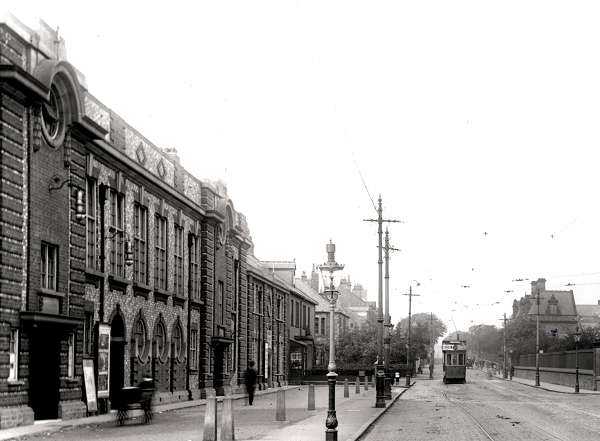
A Tyneside tram reversing on Westgate Road, Newcastle, in 1912. (Photo from Flickr, copyright Newcastle Libraries)
4. Tyneside used Corporation tracks from August 1904 for a through service from North Shields to Stanhope Street in Newcastle via Wallsend, Shields Road, Grey’s Monument and Barrack Road. Corporation trams to Stanhope Street usually reversed in Brighton Grove but there is photographic evidence that Tyneside trams ran further, on to Westgate Road and reversed there.
5. From September 1925, Tyneside were able to use the Corporation’s Gosforth Park Light Railway to provide a recreational service from Wallsend and North Shields via the North Road to Gosforth Park, looping back over the Corporation’s West Moor route to reach their own network by a junction on Benton Road (called “Tyneside Crossing”, funnily enough!).
6. Tyneside’s original services had started in September 1902 (Wallsend to North Shields), October 1902 (Wallsend to Gosforth Church Road) and June 1904 (Gosforth to Gosforth Park, this being delayed by extensive railway-related works on the North Road, over the North Eastern Railway’s new Ponteland Branch).
7. After a great deal of wrangling, combined Tyneside/Corporation operations commenced in August 1904 (except for the Neptune Road link, delayed until November 1906 by the building of a new bridge under the NER’s Riverside Branch).
8. Relations between Newcastle Corporation and the Tyneside company had soured during 1901/2, when Tyneside twice had to change their plans for a tram terminus in Gosforth because of the Corporation’s successive extensions up Gosforth High Street. First choice had been the west end of The Grove (authorised but never built), then the west end of Church Road and finally in a side-street diversion via Rothwell Road, necessary to get to the North Road beyond the Corporation’s tracks at Henry Street.
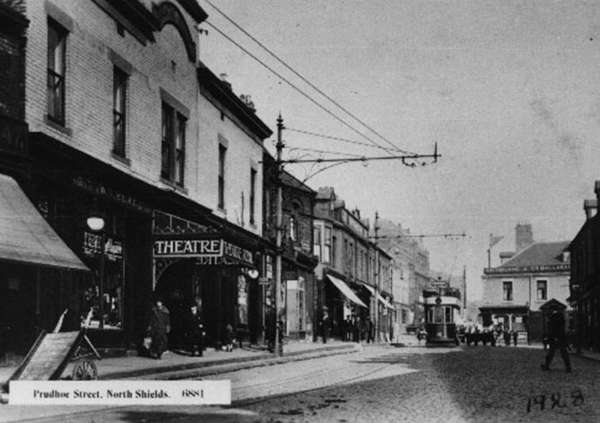
A Tyneside tram on the mixed-gauge North Shields reversing stub in Prudhoe Street, North Shields, 1925. (Photo from Tomorrows-history)
9. Tyneside’s initial terminus in North Shields was at the Prudhoe Street/Spencer Street junction, a few feet west of the Tynemouth & District Company’s reversing loop opposite the Theatre Royal. By June 1911 the famous mixed gauge section was in operation, enabling Tyneside trams to run along the north side of the Tynemouth loop to reach the far end of Prudhoe Street. A very poor photograph, with a Tyneside tram at the extended terminus, JUST shows the third rail in place.
10. Leyland PD2/3 No. 38 (BCN 889) started life as a Northern General vehicle (part of the 1389-1393 batch), hence the registration number and the single aperture destination layout. It was new in March 1951 and transferred to Tyneside in June of that year.
Tony Fox
14/11/13 - 17:45
My impression is that the initial strategy of TT&T was to build tram lines in areas adjacent to the Newcastle Corporation network and then push for running rights into the city centre of Newcastle. As well as Wallsend and Gosforth, the initial plans included a line from Benton to Forest Hall and West Moor then through Gosforth Park. The main traffic would be into Newcastle, not to Wallsend or Gosforth. The through-running agreement of July 1904 came after TT&T had introduced a Bill in Parliament and after a public campaign by TT&T in favour of through-running. It isn't surprising that relations were difficult between TT&T and Newcastle Corporation for some time after this.
My impression is also that the purpose of the Gosforth - Wallsend line was mainly to link up these areas with the base in Wallsend rather than as a traffic-spinning route in its own right.
Paul Robson
18/11/13 - 09:56
The caption indicates body of Leyland TD5 No 22 was possibly built by Roe, but it's obviously an ECW design and the location of the photo looks like Nicholas Everitt Park in Oulton Broad where many ECW official photos were taken. It's unlikely to have a body built in Leeds, drive it to Lowestoft for a photograph and return to Newcastle for delivery. Your thoughts???
Ray Stringer
18/11/13 - 13:41
As I said at the start, Ray, I do not claim that the article is 100% accurate, and I am merely pointing out that some records indicate that Roe built the bodies to an ECW design. As for the location, I am not familiar with the place you mention, so I can't argue, however, there are no landmark buildings around, and I would have thought that one set of park railings look pretty much the same as any other, so the photo could have been taken quite literally anywhere.
Ronnie Hoye
18/11/13 - 14:30
.....but Geoff Lumb on page 53 of his book Charles H Roe makes reference to May 1940 when ECW couldn't get materials for a batch of K5Gs for United Counties. Roe couldn't source some TD7s for West Riding and an agreement was made for Roe to body the K5Gs with various ECW features - including six bay bodywork - to harmonise with the rest of the UCOC fleet.
It's possible that these weren't the only ECW/Roe hybrids.
David Oldfield
18/11/13 - 15:19
I'm surprised that someone on this forum hasn't mentioned the fact that PD2/12, GTY 169 pictured above, found it's way to Samuel Ledgard after service with Tyneside!
Chris Barker
19/11/13 - 05:45
In a book on ECW (2007) by Malcolm R White the same photo is on page 23 surrounded by three others at the same location and in this instance the picture is attributed to ECW as an official photo taken by their photographer. I live in Lowestoft and the location (Bridge Road, Oulton Broad) has hardly changed and this background has appeared in many of their photos. Another place used by the Coachworks for official photos was on the seafront at North Denes. Apparently they were always taken at the same time of day because the sun and light was agreeable to the photographer and the company. Shame Leyland closed them down.
Ray Stringer
19/11/13 - 16:18
Just to add my six penn'orth to the ECW-Roe discussion, in Duncan Roberts and John Senior's book 'Eastern Coach Works of Lowestoft - a retrospect', mention is made of two senior members of C H Roe staff leaving Leeds for Lowestoft in 1936. William (Bill) Bramham was appointed General Manager of Eastern Counties' Coach Factory just a few weeks prior to it becoming ECW, and Roe's former Chief Estimator Ralph Sugden went with him. Mr Sugden was initially Assistant Stores Officer, but later became ECW's Commercial Manager and Deputy General Manager. How much influence this had on ECW design at the time is not stated, but Mr Bramham had been with Roe since 1926, and Mr Sugden since 1924, so maybe this could explain some of the similarities between Roe and ECW products around this period. The book states that "Bramham is remembered as being a warm and considerate man, who made a point of walking around the whole factory one morning each week, and speaking to everyone". (I remember being informed by several fitters some years ago that West Yorkshire's Mr H.N.(Hector) Tuff did the very same thing each week at WY's Central Works and Body Shop, whilst General Manager there. Sadly when he retired, that lovely gesture went with him).
Ray, I agree wholeheartedly that ECW should not have been allowed to close, especially given the
invaluable expertise of its staff and the excellent build quality of its coachwork. Even when Leyland was in charge, ECW maintained its reputation for good, sound products. If any proof was needed, one only has to consider the length of operational service given by the many ECW-bodied VRTs and Olympians operated in the UK.
Brendan Smith
19/11/13 - 17:58
.....and the same can also be said of Roe who went through a rough patch with early PRV metal frame bodies like the early Atlanteans. They came back to produce one of the best bodies ever (the PRV-Roe standard). However, at they end, the quality was acknowledged better than Park Royal. Indeed, SELNEC said that their best (built) Mancunians were the last (K reg) batch on 33'0" Fleetlines. [This was strange as they should have been East Lancs bodies but, due to the fire, ELCB asked to be released from the contract. The contract was given to Park Royal (who had already built Mancunians) who had their own problems and sub-contracted them to Roe.]
David Oldfield
Comments regarding the above are more than welcome please get in touch via the 'Contact Page' or by email at obp-admin@nwframpton.com
If you have a bus related article that you would like to appear on this site please get in touch via the 'Contact Page' or by email at obp-admin@nwframpton.com
All rights to the design and layout of this website are reserved
Old Bus Photos from Saturday 25th April 2009 to Wednesday 3rd January 2024